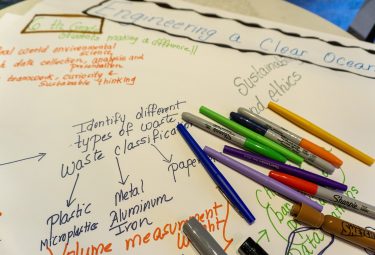Join us at the 2026 January ESIP Meeting! Register.
The Climate Literacy and Energy Awareness Network (CLEAN) – How Can You Use and Leverage CLEAN’s Resources and Tools
By Tamara Shapiro Ledley, Anne Gold, Sean Fox
The Climate Literacy and Energy Awareness Network (CLEAN, http://cleanet.org) effort has 1) created a rigorously reviewed collection of education resources that address climate and energy science, 2) developed a process for reviewing science education resources that can be engaged to include your climate and energy resources in the CLEAN Collection or leveraged to be applied to educational resources for other collections, 3) built an online review system framework that enables an organized and efficient transfer of information through the steps of the review to the publishing of the educationally useful information for the public, and 4) facilitates the CLEAN Network, a community of climate and energy literacy stakeholders. CLEAN has been funded as part of a national climate change education effort by the National Science Foundation (NSF), the National Oceanic and Atmospheric Administration (NOAA), and the Department of Energy.
1) CLEAN Peer-Reviewed Digital Collection of Educational Resources
The CLEAN Collection (http://cleanet.org/clean/educational_resources) includes currently 620+ resources comprised of learning activities, videos, visualizations, and short demonstrations and experiments. These were culled from over 14,000 existing online educational resources that directly address the Climate Literacy Essential Principles of Climate Science (CLEP, http://www.globalchange.gov/resources/educators/climate-literacy.) and/or Energy Literacy Essential Principles and Fundamental Concepts for Energy Education (ELEP, http://www1.eere.energy.gov/education/energy_literacy.html). The resources have been rigorously reviewed for scientific accuracy, pedagogical effectiveness, and technical quality and those that passed this process have been aligned with science standards (Gold et al, 2012; http://nagt-jge.org/doi/abs/10.5408/12-324.1). Resources selected for the CLEAN Collection have been provided a CLEAN Selected logo (Figure 1) to be displayed on the resource that is to provide a link back to the CLEAN Portal.
Figure 1. The CLEAN Selected Logo – provided to resources selected for inclusion in the CLEAN Collection
CLEAN Collection resources can be brought to your organizations website through syndication (e.g. NOAA’s Climate.gov Teaching Climate portal), customized web links, or with the CLEAN widget (http://cleanet.org/clean/about/widget.html).
2) CLEAN Review Process
We developed review criteria for each resource type (learning activity, visualization, video, short demonstration/experiment). The CLEAN review process includes multiple steps. Each resource first undergoes two individual reviews using the appropriate criteria. Resources that are rated highly in the individual review rounds are reviewed by a four-person panel (educators and scientists) to discuss its merits. For resources that pass the panel review the reviewers comments are captured in annotations for the users that are added to the public record of each resource. An additional expert science review is conducted once a resource passes the panel review. More details of the review process and individual review criteria can be found at http://cleanet.org/clean/community/reviewprocessabout.html.
3) Review System Framework
A review management system was developed to support the selection and vetting of the CLEAN Collection resources that are hosted within the SERC content management system in the background of the public CLEAN Portal. This web-based system facilitates the entire review lifecycle from the initial identification of potential resources to the generation of the metadata and annotations that underpin the web interface to the public collection. URL’s for potential CLEAN materials are entered by the distributed members of our team through a simple online form that checks for duplication and allows the material to be assigned to an initial reviewer on the team. From that point on the resource is tracked through the 14 internal steps of the review process. A single search and browse interface (Figure 2) serves as the central touchstone for the review team in managing the overall pool of materials under review. From this page the team can quickly identify relevant subsets of the items in the pool (e.g. all resources in the current review cycle that are waiting for a second review from a particular reviewer).
Figure 2. The CLEAN review tool showing the status of the steps in the review process for various resources (completed – green, in process – yellow, not done – red) and a faceted search enabling reviewers to quickly find the resources they need to review.
They can view the complete history of a given resource and also jump to any particular step in the review process. Each step is presented as a web page hosting the appropriate form to ‘complete’ the step: some involve assigning resources to particular reviewers, others present one of the various review forms where reviewers enter their assessment of the materials.
In the course of the review process various pieces of metadata about the resource are recorded: from alignment with the CLEP and ELEP as recorded in a controlled vocabulary, to reviewer notes about the science, pedagogy and technology of the resource. This metadata is automatically drawn into a final catalog record that is both displayed on the public site and also made available over OAI-PMH for harvesting by NSDL and NOAA’s climate.gov site.
4) CLEAN Network
The purpose of the CLEAN Network (http://cleanet.org/clean/community/cln) is to support the implementation the CLEP and ELEP through continuous communication, sharing, leveraging, and coordination across the diversity of climate change education efforts, regardless of their funding source, audience, methods, or topical/regional focus. The two main methods of engagement in the CLEAN Network are an active email list (archive: https://list.terc.edu/pipermail/climateliteracynetwork/) from which the membership (currently over 430 members) is defined, and participation in the weekly teleconference (Tuesdays 1pm ET, presentations and informal discussions recorded and posted, http://cleanet.org/clean/community/cln/telecon_schedule.html).
How can ESIP Federation members engage with CLEAN?
1. Use CLEAN Collection resources in teaching and learning about climate and energy science,
2. Disseminate the CLEAN Collection to interested groups and individuals through your website,
3. Support the development of the CLEAN Collection by serving as a reviewer on one of our review panels,
4. Provide expert science reviews for appropriate otherwise excellent resources,
5. Partner to have resources you or your organization have developed be reviewed to fill gaps in the CLEAN Collection,
6. Join the CLEAN Network to extend the reach of your network and resources and provide input to and leverage the efforts of others,
7. Partner to leverage the technology tools developed to support the CLEAN review process and collection development into efforts that you are moving forward.



